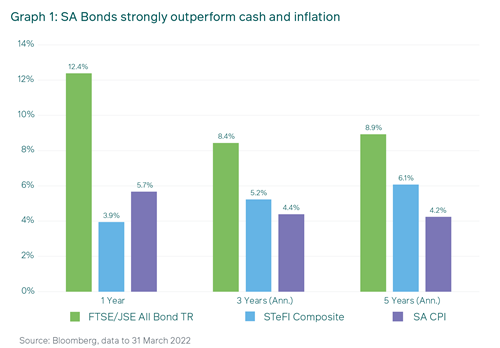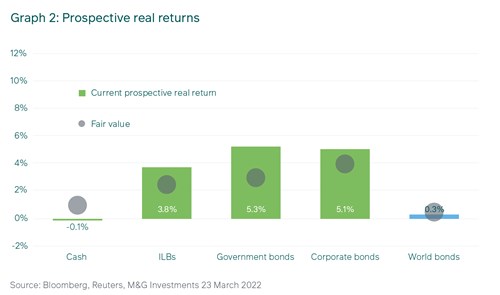The M&G High Yield Bond Fund: Taking advantage of the compelling returns on offer from SA bonds
Investors may be surprised to learn that the South African nominal bond market has delivered healthy returns to investors prepared to brave the volatility over the last few years. With excellent returns of 12.4 % over the past year and 8.9% p.a. over five years, for example, (as shown in the graph below), the FTSE/JSE All Bond Index has comfortably beaten cash and inflation by some margin. Consider that during this time investors have had to contend with the sovereign credit rating being downgraded to junk status and below, the increasingly high debt levels of the National Fiscus, the impact of Covid-19 on “SA Inc”, the July 2021 riots, and who could forget load-shedding! Given this backdrop, one could be forgiven for assuming that bonds would have been a poor investment choice, but instead the opposite has been true.

South Africans might even be more surprised to know that over the last year, SA 10-year government bonds have outperformed the comparable bonds from all the developed markets by some margin, and when it comes to emerging market peers – it’s not even close. This has occurred largely because of the local market’s exceptional cheapness, offering very attractive yields versus other sovereign debt, and improving local fundamentals.
Prospective returns still very attractive
Despite the healthy returns that South African nominal bonds have already delivered, we still believe the prospective returns available in the domestic bond market look compelling. With 10-year yields still close to 10% and longer-term inflation expectations well contained thanks to the South African Reserve Bank’s efforts, investors are looking at a prospective real return which should be above 5% p.a. – a very attractive return package, particularly when faced with a cash return which will struggle to beat inflation. The graph below illustrates the much stronger prospective real returns we expect from government bonds over the medium term compared to SA cash, SA inflation-linked bonds, SA corporate bonds and global bonds, based on their current valuations.

This impressive performance, as well as the attractive prospective returns, have not gone unnoticed by investors although, as is often the case, investment flows into the bond market have tended to lag performance. ASISA industry statistics indicate a marked shift into bond funds through 2020 and much of 2021, and in the multi-asset space there is clear evidence of funds holding higher allocations to bonds: for example, in the Multi-Asset Income category the average fund’s bond weighting rose by 6% at the expense of cash.
Given the renewed interest in bonds, we thought it might be useful to reflect on the drivers of bond fund returns, how the local bond market investment opportunity set has evolved, and how our own M&G High Yield Bond fund has responded to these changes.
Different levers for sourcing fund returns
Broadly speaking, the three primary “levers” an active manager can employ in an attempt to outperform the FTSE/JSE All Bond Index would be one or more of the following:
- Holding more corporate credit exposure than the benchmark. As corporate bonds expose investors to a higher risk of default, these bonds pay higher yields than those on similar government bonds as compensation;
- Taking views on the level and future direction of bond yield moves as interest rates change over time. This involves positioning a portfolio to be more or less sensitive to yield moves (commonly referred to a funds ‘duration’ positioning); and
- Taking positions on the shape of the yield curve (‘curve’ positioning), by identifying mis-pricing opportunities in different bonds in absolute terms and relative to each other, and looking for tactical opportunities to concentrate the portfolio in certain parts of the yield curve where analysis shows the best risk-adjusted returns are likely to be generated.
At M&G Investments we have always sought to actively use all these levers to generate returns for our clients, with market conditions, valuations and relative opportunities dictating the extent to which we employ each ‘lever’ in the fund to ensure we can meet the fund’s investment objective.
When the M&G High Yield Bond Fund was launched in 2000, the local corporate bond market was in its infancy. The fund sought to take advantage of the growth in local credit issuance in the ensuing years, as issuers sought to take advantage of the keen investor appetite for credit, as well as low levels of compensation (interest rates) investors demanded at the time.
Over the ensuing years, returns from credit holdings were a significant driver of the fund’s performance. The exposure to credit in the fund peaked following the 2008 Global Financial Crisis (GFC) at nearly 70% of the fund’s holdings as it looked to take advantage of the significantly elevated yields on offer from corporate bonds on the back of the market’s risk-aversion post the crisis. However, the GFC heralded the end of the strong growth in the local credit market largely due to the much higher levels of compensation investors started to demand.
Credit opportunities dwindle
Subsequently, credit exposure within the fund has been on a steady decline as attractive investment opportunities in the domestic credit market have diminished due to a combination of a lack of fixed-rate issuance (in particular a lack of new corporate issuers) and insufficient yields on fixed-rate credit (in our opinion) to compensate investors for the risk they assume – and we have commented on these aspects frequently over a number of years. As an example, in 2015 an investor could buy a fixed rate bond issued by a bank at a yield of 1.9% above the equivalent government bond. Today the same bond would pay you 0.15% less than the equivalent government bond! It needs little explanation then that we have actively reduced the fund’s credit exposure steadily over time, so that it is now close to zero.
With fixed-rate credit no longer offering a compelling investment return, it should come as no surprise that we have tilted the fund towards the other two ‘levers’ to drive performance to a greater extent than was the case in the past. To that end, both the fund’s duration and curve positioning have become the significant drivers of investment returns over the last number of years.
Duration positioning has the potential to generate significant performance for a fund, although the return profile can be quite ‘lumpy’ in contrast to the more-constant return profile that credit tends to deliver (assuming you avoid defaults). It is also a source of return that is more at risk from macro events that are difficult, if not impossible, to foresee such as the infamous ‘Nenegate’ or Covid-19. Curve positioning, on the other hand, allows one to exploit relative mis-pricings on the yield curve without necessarily exposing the fund to changing levels of the yield curve. Over the last 18 months, yield curve positioning has been a key driver of the fund’s performance, and we expect this to remain true as we continue to find good opportunities in this space.
We believe credit exposure is unlikely to be a significant driver of performance for the M&G High Yield Bond Fund in the foreseeable future. However, we remain hopeful that conditions in this space will at some point revert to once again offering investors value as they did in the past, in which case the in-depth research conducted by our credit team will enable us to take advantage of such opportunities.
Proposed fund name change to “M&G Bond Fund”
To ensure our fund names are aligned with the investment objective of each fund, and because of the lack of credit opportunities in the market, we have applied to the Financial Sector Conduct Authority (FSCA) to simplify the fund’s name to the “M&G Bond Fund”, a more general but also more accurate descriptor. The name change will become effective once we receive approval.
To conclude, we think domestic bonds as an asset class, and in particular a bond fund like the M&G High Yield Bond Fund, currently present investors with an attractive opportunity, given the elevated real returns on offer. They merit consideration for inclusion in investors’ diversified portfolios – particularly those investors who may be holding too much exposure to cash. We believe the M&G High Yield Bond Fund is well-positioned to deliver benchmark-beating returns going forward, on top of the healthy returns expected from the bond market.
Share
Did you enjoy this article?
 South Africa
South Africa Namibia
Namibia




 Get the Newsletter
Get the Newsletter